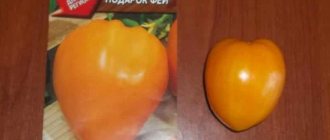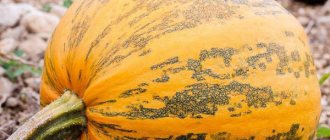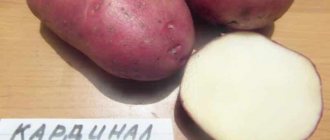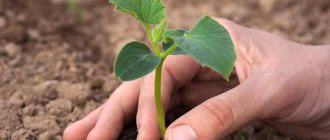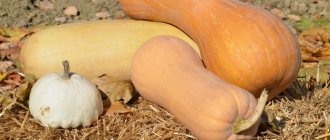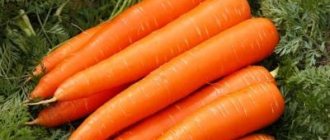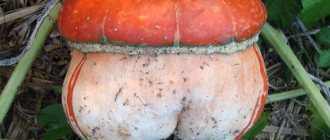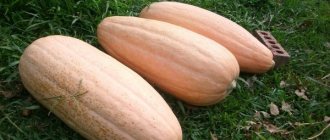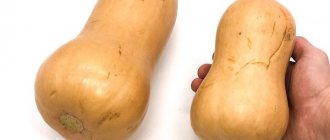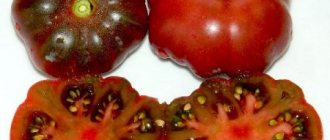Summer residents choose Vitamin pumpkin for its high yield, good resistance to many diseases and excellent taste. Let’s find out what you need to know about one of the most delicious and sweet varieties of pumpkin in order to grow it correctly and get a good harvest.
Vitamin Pumpkin is resistant to many diseases
Pumpkin Vitamin
Vitamin Pumpkin is well stored and transported
Description and characteristics of the variety
The variety was bred at the Krasnodar Research Institute of Vegetable and Potato Farming. In 1992, it was approved for use in the North Caucasus region. This pumpkin was called Vitamin pumpkin not by chance, but due to the increased content of useful elements in the fruit. Its characteristics are presented in the table:
| Parameter | Description |
| Varietal affiliation | Vitamin pumpkin belongs to the group of muscat melons, therefore it differs from other types of fruits both in its noticeable nutmeg aroma and in its elongated shape in the form of a cylinder or pear. |
| Ripening period | The variety is late-ripening - about 124-130 days (at least 5 months) pass from the moment of planting in the ground until the fruits fully ripen. For this reason, the variety is rarely grown in regions with cold climates. |
| Plant characteristics | A plant of medium thickness has vines up to 6 m long. Fruits are formed on them, usually 2-3 pieces. The greyish-green leaves are distinguished by a pentagonal shape resembling a heart. In the area of the veins they are covered with small white hairs. Each leaf is held on a long petiole (up to 25 cm). The yellow flowers are large and borne on long stalks. Due to their bright color and aroma, they attract bees and other insects that take part in the pollination process. |
| External characteristics of the fetus | Vitamin pumpkin weighs on average 4.5-6.8 kg. It has an elongated oval or cylindrical wide shape. The stalk, which can reach half of the fruit, has ribbing. The skin is thin but dense, so the fruit is easy to transport and does not require special storage conditions. It has a dark pink color with a slight orange or brown-brown tint and a segmented surface. It shows a dark green and green coarse mesh, as well as small round and elongated spots that have a lighter shade. |
| Characteristics and taste of pulp | The pulp has a rich bright orange color (close to red) and a thickness of 5 to 10 cm. It is juicy and fibrous, dense and crispy, and most importantly, it has a bright aroma and sweet taste. The seed nest is small and completely filled with loose placentas. The seeds in small quantities have a dirty yellow or brown tint. |
| The benefits of fruits and their use | The pulp of this pumpkin has a high content of nutrients. In particular, it contains 11.5-16.0 mg of carotene. Thanks to this, the vegetable has a number of positive effects on the human body - improves vision, strengthens the digestive organs, accelerates the healing of wounds, and relieves swelling. Pumpkin with such characteristics can be safely included in both baby and dietary foods. Methods of consumption - fresh or processed (the pulp is used to prepare purees, juice, baked goods and other dishes). |
| Productivity | Yield indicators are high – from 1 sq. m plot you can collect about 3.7-4.4 kg of fruit. |
| Disease resistance | The plant is relatively resistant to diseases typical of melons - powdery mildew and late blight. For preventative purposes, it should be fed with balanced mineral complexes during the period of growth, flowering and fruiting. |
The following video briefly describes the characteristics of Vitamin pumpkin:
Description of nutmeg pumpkin Vitamin
Pumpkin is one of the most useful melon plants, native to hot Mexico. Table nutmeg varieties are distinguished by their sweet pulp, from which a variety of national dishes are prepared. On Mexican plantations, yellow giants weighing more than 100 kg grow under the sultry sun.
In the Russian climate, it is almost impossible to grow a pumpkin of this size. However, thanks to the work of domestic agronomists in the research center of Krasnodar in the 50s of the 20th century, the muscat pumpkin variety Vitaminnaya was developed, in which pumpkins weighing up to 7 kg ripen in the fall. From the description of the variety it follows that Vitaminnaya pumpkin is quite thermophilic and takes root well in the south of Russia in its European part, as well as in the central and eastern parts of the North Caucasus.
Thanks to its royal size, the plant takes its place of honor in the garden. Compared to other garden crops, Vitamin Pumpkin has a powerful trunk, long-braided branches more than 600 - 650 cm long and round pumpkins.
According to the photo of the Vitamin pumpkin, the leaf is formed by pentagonal plates resembling a heart. The leaves are uniformly colored green, supported on long petioles, each of which is covered with short white hairs.
Large yellow pumpkin flowers are attached to long stalks. The bright color and aroma attract bees and insects that participate in the pollination process.
Description of fruits
In the beds, ripe pumpkins of the Vitaminnaya variety do not particularly stand out among other hybrids:
- round or oval fruits;
- the peel is dense, smooth or with slight ribbing;
- In color, mature pumpkins can be completely beige, yellow, orange and even coral shades.
The Vitamin variety of butternut squash often has colored spots or characteristic stripes on its sides.
Butternut squash produces the most delicious and sweet fruits, the flesh of which is juicy and fibrous, with a rich yellow-orange color. When cut, the vegetable looks very appetizing and emits a pleasant sugary aroma.
Nutmeg varieties make excellent vegetable smoothies. This drink contains a lot of useful substances for the body:
- vitamins A, C, group B, PP, D;
- unique vitamins T - to prevent anemia and K - for protein synthesis in the blood;
- carotene, pectin, ascorbic acid, etc.
Eating butternut squash is beneficial for children and adults
Women who want to lose weight should pay close attention to this amazing vegetable. Melon culture contains plant fibers that saturate well and relieve excess weight.
It's amazing how healthy you can improve your body by simply adding pumpkin to your diet:
- the high content of potassium, magnesium, manganese and vitamin groups will improve the condition of the skin and hair;
- the water-salt balance in the body increases;
- excellent prevention of heart and vascular diseases is carried out;
- blood pressure, gastrointestinal function and much more are normalized.
Pumpkin is an amazing low-calorie product, containing about 22 kcal per 100 g. You can easily grow a vegetable that serves as a storehouse of health in your own garden.
Planting methods and timing
Vitamin pumpkin is an extremely heat-loving plant, for which temperature changes are fraught with falling leaves, blackening of the trunk and death. In this regard, it is best to grow pumpkin in seedlings. Direct sowing in open ground is permissible only for residents of the southern regions, where the crop can be harvested in mid-autumn and without fear of frost.
When grown from seeds, the ripening period is delayed, so the warm season will not be enough for the active development of the crop.
In any case, at the time of planting, the soil temperature should be at least +13°C, otherwise the tender roots will die in a cool environment. This will be indicated by withered leaves covered with dark spots.
The timing of planting depends on the method of cultivation:
- Through seedlings . You need to sow the seeds in April in order to transplant the seedlings into open ground in May-June. In this case, the temperature on the thermometer should already remain steadily at least 20°C.
- Direct sowing of seeds into the ground . Sowing work can be carried out at the end of May - at the beginning of June, when the risks of uninvited frosts will be minimized. To determine the optimal time for sowing seeds, you can also rely on folk signs. They say that pumpkin can be planted when viburnum and peonies begin to bloom.
Vitamin pumpkin prefers sandy, sandy loam and light loamy soils for any cultivation method.
Growing technology
Muscat pumpkins are grown in sandy, sandy loam and light loamy soils. Vitamin pumpkin seeds are sown in soil warmed by sunlight, preferably at the end of May. If the temperature drops below 20 o C, then the tender pumpkin roots die off in the cool soil. The first sign of wilting will be withered leaves with dark spots.
It is allowed to grow nutmeg pumpkins only in seedlings. Their late varieties are popularly called “winter”. Growing from seeds will further delay the ripening period. In this case, the warm season will not be enough for the period of active plant growth.
The container for seedlings must be spacious enough, with a diameter of at least 10 cm. This is necessary for the development of the root system.
The beds are prepared as for all vegetables:
- dig and clear of debris and roots;
- break earthen stones;
- make furrows 10 cm deep.
Seedlings should be planted in the ground from a container, preserving the earthen clod. When planting plants, maintain a step of 50 - 60 cm from each other. Pumpkin loves free space to spread its wide leaves freely.
Planting through seedlings
When growing pumpkin in seedlings, the probability of obtaining a rich harvest is greater than when directly sowing seeds in the ground, however, this method is also more labor-intensive, so it is advisable to roughly divide it into several stages.
Seed preparation
The following processing of self-harvested or purchased seeds is carried out sequentially:
- Warming up . The seed should be spread in a thin layer on a pallet and kept for 1-2 months in a warm place, for example, near a stove. Such manipulation will allow the plant to produce a larger number of female flowers, which will have a positive effect on the crop yield.
- Germination test . After warming up, the seeds need to be soaked in a saline solution. Those specimens that emerge must be caught and destroyed, since they are empty and will not produce any shoots. The seeds remaining at the bottom can be used for further processing.
- Hardening . In order for future seedlings to withstand temperature changes, they need to be hardened. For these purposes, selected specimens will need to be wrapped in a damp cloth and kept in the refrigerator for 3 days.
- Disinfection . Carried out to protect the future plant from pest attacks. To do this, the seeds need to be soaked for 10-12 hours in warm water with the addition of a small amount of potassium permanganate or aloe juice.
Sowing seeds for seedlings
At the beginning of May, you can already plant seeds for seedlings. To do this, you will need to prepare separate peat pots, since the crop does not tolerate picking. In order for the root system of the plant to fully develop, the planting containers must be spacious and have a diameter of at least 10 cm.
Planting seeds is done in the following order:
- Fill the pots with nutritious soil.
- Make 2 cm indentations in the pots and place 1-2 seeds in them.
- Lightly sprinkle the holes with soil, and then water it with a spray bottle to lightly moisten it.
- Cover the plantings with plastic wrap to create a mini-greenhouse.
- Place the containers in a sunny place and regularly open the film for ventilation. With the appearance of the first shoots it can be completely removed. In addition, it is necessary to constantly maintain soil moisture, while avoiding excessive moisture.
With the right agricultural technology, the pumpkin will sprout quickly, and it can be transplanted into open ground in early June. By this time the plant should already have 3 leaves.
Transplantation into open ground
The plant does not tolerate acidified soil well, so it is necessary to normalize its acidity after adding organic matter using wood ash. It is enough to scatter it over the beds or prepare a solution for irrigating the soil (2 tablespoons per 1 liter of water). The area should also be fertilized in the fall. An alternative option is to plant green manure.
It is worth replanting the seedlings into a properly prepared bed, following these instructions:
- Dig up the bed, clearing it of debris and plant debris.
- Break the earthen stones.
- Dig small holes 10 cm deep at a distance of 60-100 cm from each other. You should not allow very thick plantings, as this will prevent the wide leaves of the plant from spreading out to their full potential.
- Fill the dug holes with hot water (not lower than 50°C) at the rate of 2 liters per hole if the weather is dry.
- Plant one stem in each hole and cover with soil, completely covering the root collar.
- Mulch the planting with manure or peat. If there is a threat of night frosts, the planting should be temporarily covered with a transparent film.
Vitamin pumpkin variety
Description of the variety. The variety is late in ripeness, up to 140 days before harvest. Growing in cool regions is not recommended. So, as soon as in the southern regions the variety has time to ripen before the first frost. It is recommended to plant seedlings.
The fruit is elongated, very large, weighing up to 7 kg. The pulp is firm but tender, orange in color. The peel is thin. Pumpkin is sweet in taste and very fragrant. You can safely eat it raw. This variety bears fruit well and easily tolerates long-term transportation.
The name of the variety speaks for itself; “vitamin” pumpkin contains a huge amount of useful vitamins. The fruit of this variety is considered dietary, so it is used in making purees for babies. If you have chosen this variety, then you already know its medicinal properties. It has a beneficial effect on the body, namely:
- improves vision;
- relieves swelling;
- has a beneficial effect on the immune system;
- strengthens the intestines;
- promotes wound healing;
- strengthens the reproductive system.
And these are just the main effects of consuming this vegetable. The seeds located inside the fruit also bring great benefits.
Features of cultivation
The variety is best grown as sprouts. Seeds are planted in open ground only in the southern regions. In colder cities, you may simply not have time to harvest before the first frost.
The average temperature for planting should be at least 12 degrees. Do not plant seeds too early; pumpkin does not tolerate transplantation well. They need to be planted in early May, preferably in small peat pots.
Seeds must be prepared in advance:
- You need to warm it up next to the radiator for a couple of months, this will give more female inflorescences.
- Check for germination. To do this, the seeds are soaked in a salted solution; seeds that do not sink are not suitable.
- Soak the seeds in warm water for the whole day, and it is advisable to change the water a couple of times. For disinfection, it is worth adding aloe or a little potassium permanganate solution.
- Harden the seeds. You need to put the seeds in a wet cloth and put them in the refrigerator for three days. This will help the seeds tolerate unstable climatic conditions. But this is not necessary.
Seedlings are planted in open soil in early June. By that time, the sprout should already have three leaves. Pumpkin seeds are planted at the same time. To protect against sudden frosts, you can cover with film or covering material.
Before planting, you need to pour hot water into the hole, at least two liters for each hole.
Pumpkin of the “Vitaminnaya” variety is not demanding in care, but does not like the cold at all. It is better to make high beds, which it is advisable to mulch in advance. The distance between the holes should be about a meter. Plant one sprout per hole or throw in 2-3 seeds.
Weeding and loosening the soil plays an important role in care to saturate the roots with oxygen. You need to water regularly, strictly at the root, without wetting the leaves.
Pumpkin does not like acidic soil. To normalize acidity, wood ash is suitable for you.
Direct sowing into the ground
In the southern regions, this heat-loving crop can be grown by direct sowing of seeds in open ground. This method requires compliance with the following rules:
- To get a good harvest, you need to prepare the site in advance, taking care of all the fertilizers. For 1 sq. m will need to introduce 6-8 kg of humus. There is an easier way - before planting, place a handful of humus in each hole.
- Arrange the holes in rows according to a 60x60 cm pattern.
- The optimal depth of the holes is about 10 cm. You need to put 2-3 seeds in each of them, and then sprinkle them with earth.
- Mulch the holes with peat on top.
Pumpkin care
It consists of carrying out a set of agrotechnical measures, each of which requires separate consideration.
Watering, loosening and weeding
There is no special scheme for watering the soil, but it must be regular to prevent the formation of a dry crust on the surface of the area. In this case, it is worth focusing on weather conditions: in drought it is worth irrigating the plant 2 times a day at the rate of 5 liters of water per bush, and in rainy weather - water as needed. Pumpkin also needs especially abundant watering (twice a day) during flowering and fruit set.
You need to pour warm water strictly at the root so that droplets do not fall on the leaves and vines. The fact is that they can leave behind dry spots and cause burns to the plant.
At the end of summer, it is necessary to reduce the frequency of watering and completely interrupt it 2 weeks before harvest. Otherwise, the skin of the fruit will be too thin and the flesh will be watery. Such a pumpkin cannot be preserved until winter, since it will quickly deteriorate.
After watering, it is also worth loosening the soil around the plant and weeding to provide air access to the plant’s roots.
Additionally, the ground under the bush should be mulched with humus or straw. This manipulation will retain moisture longer and prevent the growth of weeds.
Feeding
For nutmeg pumpkin varieties, the following fertilizing scheme is used:
- First feeding (before flowering) . With the seedling method, it is carried out 7 days after planting the seedlings in open ground, and with direct sowing - after 3 weeks. For feeding, you should use a solution of mullein or manure, where most of the liquid is removed (1:10). You can also add mineral fertilizers to it - 30-40 g of superphosphate, 15-25 g of potassium sulfate per 10 liters of water.
- Second feeding (during flowering) . The plant should be fed with a solution of 50 g of potassium sulfate and 15-20 g of nitrophoska per 10 liters of water. Until the ovaries appear, it can also be fertilized with wood ash or garden mixture at the rate of 50 g of dry matter per 10 liters of water. In case of cold summer, the plant can be additionally sprayed with a urea solution at the rate of 10 g per 10 liters of water.
If the application of organic fertilizers (mullein infusion or chicken manure diluted in water) increases the acidity of the soil, it will need to be lowered using wood ash. You can simply scatter it over the surface of the bed or add it with watering, having previously prepared a solution at the rate of 2 cups of ash per bucket of water.
Thinning
This manipulation is relevant only for direct sowing of seeds in open ground. It is carried out with the appearance of the first shoots. If 3-4 bushes sprout in one hole, you need to leave one or two of the strongest ones.
Thinning of seedlings is carried out only after the formation of several leaves. Weak specimens cannot be pulled out, as this can cause irreparable damage to all entrances. So, they need to be carefully cut at ground level with garden shears.
Bush formation
To get a good harvest, you must pay due attention to caring for the vines. This involves the following activities:
- During the development process, the pumpkin produces many weaving stems, which, with the help of tendrils, are fixed in the soil and supply the plant with nutrients along its entire length. As soon as it grows, in the places where the tendrils appear, such shoots should be sprinkled with earth and watered. They cannot be moved or cut.
- After the main stem reaches 1.5 m in length, it needs to be pinched.
- When forming bushes, you need to leave 2 lashes on each of them. The rest need to be carefully torn off.
- Leave 2-3 ovaries on one plant, since more fruits still won’t have time to ripen. To do this, the stems must be pinched 50 cm above the fruit.
- Pin the lashes to the ground in several places and sprinkle them with a layer of soil to speed up root formation and promote fruit growth.
For better development in the fall, it is worth placing a board or brick under each vegetable. You can use a more complex option - hang the fruits in a net from a support.
Pest Control
Pumpkin is not the most attractive treat for pests. If they appear, it is mainly at the end of the growing season, when this crop ends its life cycle. Among them you can find:
- pumpkin glass;
- South American leaf beetles;
- edgers or diamondbacks.
The first pest poses a great danger because it eats the stems from the inside. After it attacks the plantings, the plant has little chance of survival. The listed pests must be controlled mechanically. This means that the plantings must be regularly inspected and any pests found must be manually removed.
Useful properties of pumpkin
In addition to the fact that the orange beauty is an incredibly tasty vegetable, it also has numerous beneficial properties. The pulp of nutmeg pumpkin contains in large quantities:
- vitamins A, C, B, B6, E, K and others;
- potassium, magnesium, manganese.
The vegetable is dietary, low-calorie, and is widely used in baby food. In terms of carotene content, pumpkin is “ahead” of carrots, so it should be eaten by those who have vision problems.
Pumpkin fruits are false berries that help remove harmful waste and toxins from the human body, promote kidney health, and slow down the aging process of the body. It is useful to consume this tasty vegetable to improve blood clotting, for people suffering from heart disease, as well as for those who want to improve immunity.
Pumpkin must be on the menu, as it improves metabolism, preserves male strength and helps preserve the beauty of lovely ladies and burn “extra” pounds. Traditional healers consider this vegetable very useful for cancer patients. By the way, not only the pulp, but also pumpkin seeds are used in medicine. They are a very effective remedy in the fight against various parasites of the human body, and pumpkin seed oil is used in the treatment of the prostate gland in men.
And, of course, nutmeg pumpkin has found application in cooking. Its pulp is best consumed fresh, using in salads. Mashed potatoes, various side dishes and cereals turn out delicious; you can also make excellent pancakes from the pumpkin contents. Small nutmeg pumpkin is stuffed, and you can use vegetables or meat as a filling. Pumpkin pies, halva and candied fruits are popular.
Harvesting and storage
Harvesting must be done from September to October inclusive, before the onset of the first frost. The following signs will indicate the biological maturity of the fruit:
- the appearance of a clear pattern on the hardened crust;
- drying out of the stalk.
It is better to remove ripe fruits from the garden in dry weather. They need to be carefully cut with a small stalk (5-6 cm), which facilitates their longer storage.
The collected fruits must be sorted correctly. Those that have mechanical damage or have not reached technical ripeness must be processed immediately, while the rest can be stored for winter. Additionally, they should be dried in a warm room or kept in the sun for 2 weeks.
Before the onset of cold weather, the fruits can be stored on the balcony or in a dry room. The main thing is that at night the temperature does not drop below +5...+8ºC. With the arrival of cold weather, the pumpkin needs to be moved to a warm place. A large harvest can be stored in the garden, in a trench, covered with a thick layer of straw and sprinkled with earth. It is important to leave holes for air circulation.
Fruits in storage must be regularly inspected in order to promptly detect signs of spoilage, remove damaged specimens and eat them.
Advantages and disadvantages
Vitamin Pumpkin is one of the leaders among nutmeg varieties due to the following advantages:
- high yield rates (up to 9 fruits can be obtained from 3 seedlings);
- rapid rooting of seedlings in open ground and active flowering;
- resistance to various diseases and pests;
- good transportability;
- excellent taste for preparing various dishes.
The disadvantages of this variety of melons include:
- excessive thermophilicity (pumpkin is mainly adapted to the weather conditions of the southern regions, therefore it dies at cold temperatures);
- late ripening;
- active growth (the plant occupies a large surface of the bed due to powerful stems, spreading leaves and heavy pumpkins).
The pumpkin grows in all directions and spreads widely throughout the entire bed, so dense planting should not be allowed.
Reviews about the variety
★★★★★
Margarita, 35 years old, Sochi. I have been cultivating nutmeg pumpkin on my plot for two years now.
The whole family liked this variety for its sweet taste. The thin orange pulp makes excellent dishes. ★★★★★
Svetlana Petrovna, 50 years old, Krasnodar. Pumpkin has been in my garden for a long time.
I especially like the Vitamin variety. I can note its high germination rates and resistance to many diseases that often affect melons and melons. During flowering, the bushes are strewn with bees and butterflies, so the fruits set and grow by leaps and bounds. I recommend it to everyone! ★★★★★
Andrey Stepanovich, 58 years old, Moscow. My neighbor shared her Vitaminnaya pumpkin seeds.
I took a chance and planted through seedlings. I was surprised at what a rich harvest we managed to reap from a couple of bushes. It was not possible to consume all the fruits during the season, so I put them in storage. The keeping quality of this variety is excellent. Hide
Add your review
The experience of growing Vitamin pumpkin is also described in the video below:
Vitamin pumpkin is highly valued by lovers of this vegetable crop because it has excellent taste and is rich in folic acid, carotene, vitamins and minerals. It can be easily grown by residents of warm regions, since it is a heat-loving and late variety of melons. In unfavorable weather conditions, pumpkin can be grown in seedlings in a greenhouse.
0
0
Copy link
